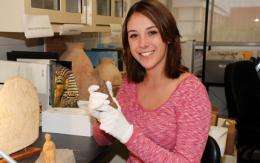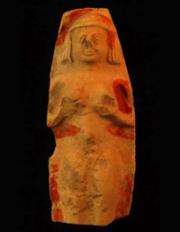Exploring the Rise and Demise of Empires

(PhysOrg.com) -- Archaeology senior Sarah Hawley presents her research on ancient figurines -- which reveals information about the transition of empires -- during prestigious annual conference.
When Sarah Hawley took her first archaeology course in USC College, she did not know it would be a watershed experience.
Entering USC to study theatre the year before, she was immediately hooked and switched her major.
"Archaeology is something that every child wants to do," said Hawley, now a senior and president of the Society of Trojan Archaeologists, a student-run group. “It’s history, but hands on. It’s adding an adventure component to something that you could also do in the library.”
Hawley’s search for adventure and knowledge led her to inquire, her sophomore year, about potential undergraduate research projects conducted by her adviser and archaeology lecturer Lynn Swartz Dodd. Soon, Hawley found herself in Turkey, working on the Tell al-Judaidah Publication Project, headed by Dodd in collaboration with the University of Chicago’s Oriental Institute.
The work Hawley began her sophomore year culminated this January, when she was chosen to present her research at the 2010 joint meeting of the Archaeological Institute of America (AIA) and the American Philological Association (APA) in Anaheim. The annual meeting is the largest and oldest of its kind in North America. This year’s gathering had 2,000 attendees, including Hawley, archaeology undergraduate Jenny Crawford and Dodd. Hawley also spoke at the event.

“This is a very competitive conference,” Dodd said. “Some of my own advisers, [who are] senior professors, have submitted proposals to give papers and haven’t been accepted. It’s unusual, if not singular, for an undergraduate to get a paper slot.”
Hawley’s presentation focused on Persian and Greek figurines found at the Tell al-Judaidah site and what they tell archaeologists about the transition of empires.
“Figurine research is an interesting and compelling project,” Dodd said. “It gives you a sense that these obscure clay objects that have been broken and lying on the ground for thousands of years can help us unlock the secrets of imperialism. Archaeologists want to understand humanity and why society works the way it does, and that’s really the focus of Sarah’s project.”
Tell al-Judaidah is a large mound, rising 30 meters, in the Amuq Valley of southeastern Turkey near the Mediterranean coast. The site has historic importance because the sequence of its habitation runs from the Neolithic (Stone Age) period to early Christianity. It is a foundational reference collection; looking at the layers of the site is much like flipping through a book of ancient history.
The site was excavated by archaeologist Robert Braidwood in the 1930s, but only artifacts from the earlier part of history, from the Stone Age to 2,000 B.C., were published. The Tell al-Judaidah project seeks to publish information from the latter half of the site. Hawley’s research focuses on documenting and publishing hundreds of figurines from the Greek and Persian periods.
“The main focus of my presentation and one of the points I want to highlight in my [research] article is that empire transition can be seen,” Hawley said at the College’s Archaeology Research Center, pointing to a photograph of a figurine’s head, which wore a Macedonian headdress, rather than a Persian one. “It’s about how the forms are modified when the Hellenistic period started.”
By studying the way that the Persian rider, one type of statuette important in its depiction of Persian military strength, was modified to reflect Greek military strength, Hawley postulates that the figurines were propaganda. She believes they show an active modification of culture that coincided with the empire transition of Alexander the Great and his conquest of the East. Her full analysis will be added to the peer-reviewed publication, currently being compiled.
The Tell al-Judaidah project and the Archaeology Research Center have provided Hawley with the unique opportunity as an undergraduate to travel the world, conduct her own research, present and speak at a conference, and publish her work.
“USC has a very active archaeology research program for undergraduates,” Hawley said. “This is something that is very rare in schools. Usually undergraduates don’t get to touch the artifacts, much less publish articles or present. We are doing graduate level work here in the lab.”
Graduate school is where Hawley plans to go next, either in Turkey or Britain, though she says she will continue work on the Tell al-Judaidah project as well.
“Archaeology is a lot of hard work and most of it is laboratory work,” Hawley said. “But what motivates me is that it’s a nice mixture of history, science, adventure, getting dirty, and getting to travel.”
“Why not do this? It’s something interesting, it’s an opportunity I have and it’s all about building up experience and learning as much as I can, while I can.”
Provided by USC College
















